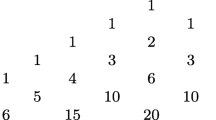Abstract
Binomial coefficients are used in many fields such as computational and applied mathematics, statistics and probability, theoretical physics and chemistry. For accurate numerical results, the correct calculation of these coefficients is very important. We present some new recurrence relationships and numerical methods for the evaluation of binomial coefficients for negative integers. For this purpose, we give some comparisons of the outputs for different computer programming languages in case of negative integers, and also we wrote two new algorithms for computations.
Similar content being viewed by others
References
L. Wei, “Unified Approach for Exact Calculation of Angular Momentum Coupling and Recoupling Coefficients,” Comp. Phys. Commun. 120, 222–230 (1999).
Y. Tourigny and P. G. Drazin, “The Asymptotic Behavior of Algebraic Approximants,” Proc. R. Soc. London A 456, 1117–1137 (2000).
Z. Zhang and J. Wang, “Some Properties of the (q, h)-Binomial Coefficients,” J. Phys. A Math. Gen. 33, 7653–7658 (2000).
G. Flynn, J. Rasmussen, M. Tahic, and M. A. Walton, “Higher-Genus su(N) Fusion Multiplicities as Polytope Volumes,” J. Phys. A Math. Gen. 35, 10129–10147 (2002).
T. Ozdogan and M. Orbay, “Cartesian Expressions for Surface and Regular Solid Spherical Harmonics Using Binomial Coefficients and Its Use in the Evaluation of Multicenter Integrals,” Czech. J. Phys. 52, 1297–1302 (2002).
M. Schork, “Fermionic Relatives of Stirling and Lah Numbers,” J. Phys. A Math. Gen. 36, 10391–10398 (2003).
L. Q. Wei and A. Dalgarno, “Universal Factorization of 3n-j (j > 2) Symbols of the First and Second Kinds for SU(2) Group and their Direct and Exact Calculation And Tabulation,” J. Phys. A Math. Gen. 37, 3259–3271 (2004).
T. Takagi, “Inverse Scattering Method for a Soliton Cellular Automaton,” Nuclear Phys. B 707, 577–601 (2005).
S. M. Nokhrin, J. A. Weil and D. F. Howarth, “Magnetic Resonance in systems with Equivalent Spin 1/2 Nuclides, Part 1,” J. Magn. Reson. 174, 209–218 (2005).
M. Yavuz, N. Yükçü, E. Öztekin, S. Döndür, and H. Yilmaz, “On the Evaluation Overlap Integrals with the Same and Different Screening Parameters over Slater Type Orbitals via the Fourier-Transform Method,” Commun. Theor. Phys. 43, 151–158 (2005).
E. Oztekin, “Overlap Integrals with Respect to Quantum Numbers over Slater-Type Orbitals via the Fourier-Transform Method,” Int. J. Quant. Chem. 100, 236–243 (2004).
M. Orbay, T. Özdoğan, and S. Değirmenci, “Evaluation of Two-Center Overlap Integrals Using Slater Type Orbitals in Terms of Bessel Type Orbitals,” J. Math. Chem. 37, 27–36 (2005).
T. C. Lim, “Polynomial Forms of Typical Interatomic Potential Functions,” J. Math. Chem. 38, 495–501 (2005).
T. Doslic, “Perfect Matchings in Lattice Animals and Lattice Paths with Constraints,” Croat. Chem. Acta 78, 251–259 (2005).
I. G. Zenkevich and A. A. Rodin, “Gas Chromatographic One-Step Determination of the Number of Hydroxyl Groups in Polyphenols with Mixed Derivatization Reagents,” Zh. Anal. Khim. 57, 732–736 (2002).
B. A. Mamedov, “Calculation of Two-Center Nuclear Attraction Integrals over Slater Type Orbitals in Molecular Coordinate System,” Chin. J. Chem. 22, 545–548 (2004).
T. C. Lim, “Application of Binomial Coefficients in Representing Central Difference Solution to a Class of PDE arising in Chemistry,” J. Math. Chem. 39, 177–186 (2006).
M. Abramowitz and I. A. Stegun, Handbook of Mathematical Functions with Formulas, Graphs, and Mathematical Tables (Dover, New York, 1965).
I. S. Gradshteyn and I. M. Ryzhik, Tables of Integrals, Series, and Products (Academic, New York 2000).
B. G. Arfken and H. J. Weber, Mathematical Methods for Physicists (Academic, London, 2005).
R. Sprugnoli, “Negation of Binomial Coefficients,” Discrete Math. 308, 5070–5077 (2008).
P. Henrici, Applied and Computational Complex Analysis (Wiley, New York, 1977), Vol. 2.
S. Wolfram, Mathematica: A System for Doing Mathematics by Computer (Addison-Wesley, Reading, Mass., 1998).
A. Gilat, MATLAB: An Introduction with Applications (Wiley, New York, 2004).
F. Y. Wang, Physics with Maple: The Computer Algebra Resource for Mathematical Methods in Physics (Wiley-VCH, Weinheim, 2006).
Author information
Authors and Affiliations
Corresponding author
Additional information
The article is published in the original.
Rights and permissions
About this article
Cite this article
Yükçü, N., Öztekin, E. Strategies on the evaluation of binomial coefficients for all integers. Comput. Math. and Math. Phys. 53, 1–7 (2013). https://doi.org/10.1134/S0965542513010119
Received:
Accepted:
Published:
Issue Date:
DOI: https://doi.org/10.1134/S0965542513010119




